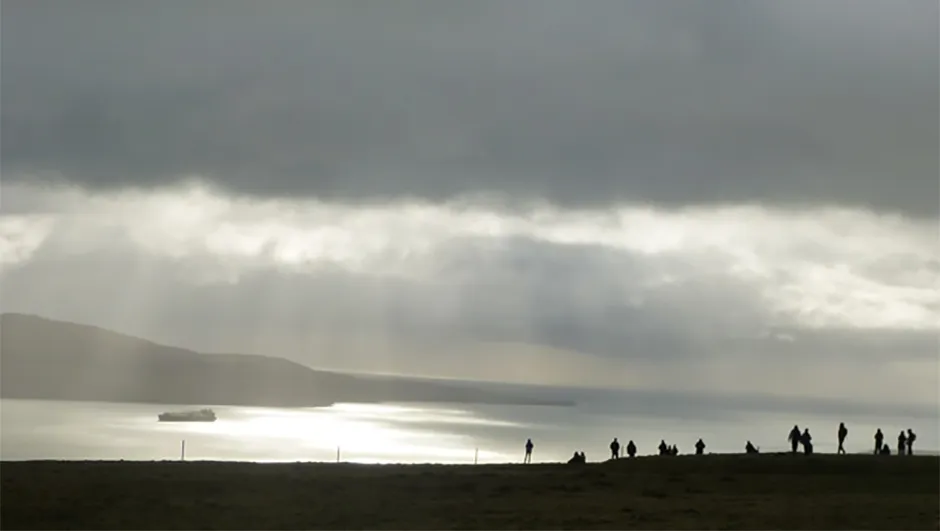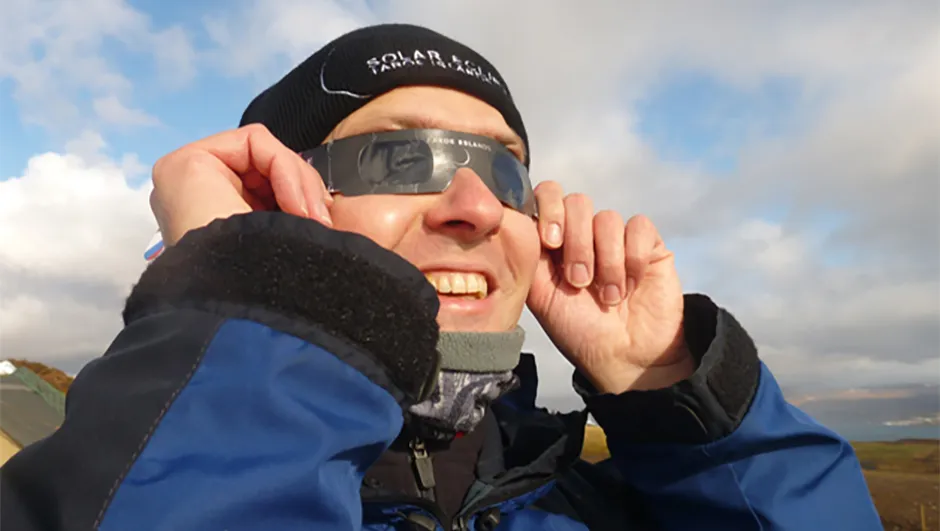The Diamond Ring from Midvagar, Vagar Island. Credit: Nick Glover
Was a cloudy eclipse for the Faroe Islands predictable? Yes.
Was it dramatic and unforgettable? Absolutely. Some saw totality, most didn't.
A few photographed the Sun's corona, and even the Diamond Ring, others got pictures only of a partial eclipse or that Faroe Islands favourite – heavy clouds.
Some wept with happiness, some complained bitterly.
Some filmed music videos, and a few even held-up slotted spoons to project Crescent Suns (OK, just me!).
There was even a unique 'Diamond Ring' engagement after one eclipse-viewer proposed to his fiancée moments after witnessing totality.

As much of Britain missed-out even on viewing the partial eclipse of the Sun, those in the remote Faroe Islands in the North Atlantic ocean had to withstand what's commonly known to eclipse-chasers as 'a lot of weather.'
The early hours of Friday were tense, with the 9,000 visitors to the Faroe Islands – on land and aboard 10 cruise ships – nervously waiting for First Contact at 08:39am while under thick, but fast-moving cloud.
Some got in their cars are headed west – a very wise move, in retrospect – though most stayed in Tórshavn and took the 30% chance of clear skies.
Stressful morning
The odds were not good.
“It's very stressful – I'm not very pleasant on the morning of the eclipse,” said Fred Espenek, a retired astronomer who calculated eclipses for NASA and is known as 'Mr Eclipse', a veteran of 26 total solar eclipses.
Espenek, like the 2,000 others that stood above Tórshavn at the Hotel Føroyar, missed out on totality.
“I don't want to talk about it,” he said later on that day. “It was horrible.”
Others were more forgiving.

“Totality disappeared, but it was great experience,” said astronomer Andy Green, a veteran of multiple eclipses and aurora hunts who was leading 44 Brits on a trip for Nordic Experience.
“In many ways it was like China in 2009 – we were lucky to see anything based on the weather we've had this week.” Green saw First Contact and Fourth Contact, and everything in between – except totality – but it was so, so close.
“I saw the Crescent Sun about ten seconds after totality, just as Baily's Beads would have been visible, but for the cloud, but we need to be thankful for what we did see,” said Green, who later that day did find the Northern Lights for his guests.
Clear view of totality
Only a few eclipse-chasers in the Faroe Islands had a clear view of the 'celestial bullseye' of totality.
The mainly British guests aboard the P&O Cruises' ship Oriana – which had failed to dock at Tórshavn in the hours before the eclipse and had headed back out to sea – did get to see totality.
Though some claim to have seen 15 seconds of totality from Tórshavn, it was the western island of Vágar that did best – and also got 20 seconds 'extra' totality.
Some had driven there after breakfast, some had slept in cars on the side of remote fjords, while others had been staying with local Faroese families in Sorvágur – the true 'totality honey-pot' where almost the entire partial phases were visible, too.
The images from there – from photographers including US journalist and photographer Eric Adams, whose images flashed around the world – were stunning and, to most of us on the Faroe Islands, rather surprising.
A close call
Eclipse-chasers who stayed away from the Faroe Islands will now delight in saying 'I told you so', but in truth none of the 8,000 people here were more than a few seconds away from witnessing a true classic eclipse.
However, in unlucky Tórshavn, the eclipse was almost completely clouded-out from First Contact at 08:39am until totality at 09:42am.
A glimpse of a Crescent Sun – through cloud with the naked eye – was visible a tantalising 10 or so seconds after Third Contact.
Some even saw Venus during totality in a patch of clear sky nearby.
Having watched an eclipse in a large crowd before, I de-camped to Húsareyn, a mountain higher above Tórshavn, though still over-looking its harbour.
At 345m, it would give me a slightly better chance of being above the clouds.
In the event, it didn't, but there were other reasons to be on Húsareyn.
As well as a folk band and snacks like cod and Faroese lamb sausage, the organisers NAXhad brought horses, sheep and hens to the viewing area.
How would they react during totality when the darkness fell?

I was keen to see, but when darkness did fall, there was little change; the horses went about their business and the sheep made no sound.
Perhaps we were asking too much.
“Animals on the Faroe Islands get all weather at all times and the light changes constantly – they are probably used to it!” said an organiser for NAX, who promptly served everyone fish soup, fish muffins and Føroya Bjór's Sólarbjór – Solar Beer – specially brewed in complete darkness, and under a full moon!

'Community spirit'
The community spirit and tranquil wilderness up on Húsareyn made this one of the most natural, most serene eclipses I've witnessed.
“I think it may have turned me into an eclipse-chaser,” said Geraldine Brookes from Vancouver, Canada, who had anticipated it getting darker than it did.
“I'm so glad I saw my first eclipse in this kind of environment. It's very folksy and down to Earth, and it feels like a community putting together an experience … and there is something so awe-inspiring about the whole event.”

Many people used solar glasses to observe the eclipse. Credit: Jamie CarterFor those of us who've seen totality before, such a near-miss is painful; we know what we, and everyone is missing.
Totality has to be seen, and felt, to be believed – to look at a hole in the sky is unbeatable in its strangeness.

Up on Húsareyn, perhaps the most dramatic part of the eclipse was the last fifteen seconds before the end of totality, when the light levels began to rise rapidly and a silvery, almost black-and-white light spread across the surrounding, jaw-dropping scenery, with the Sun's light appearing on the expanse of water before us.
